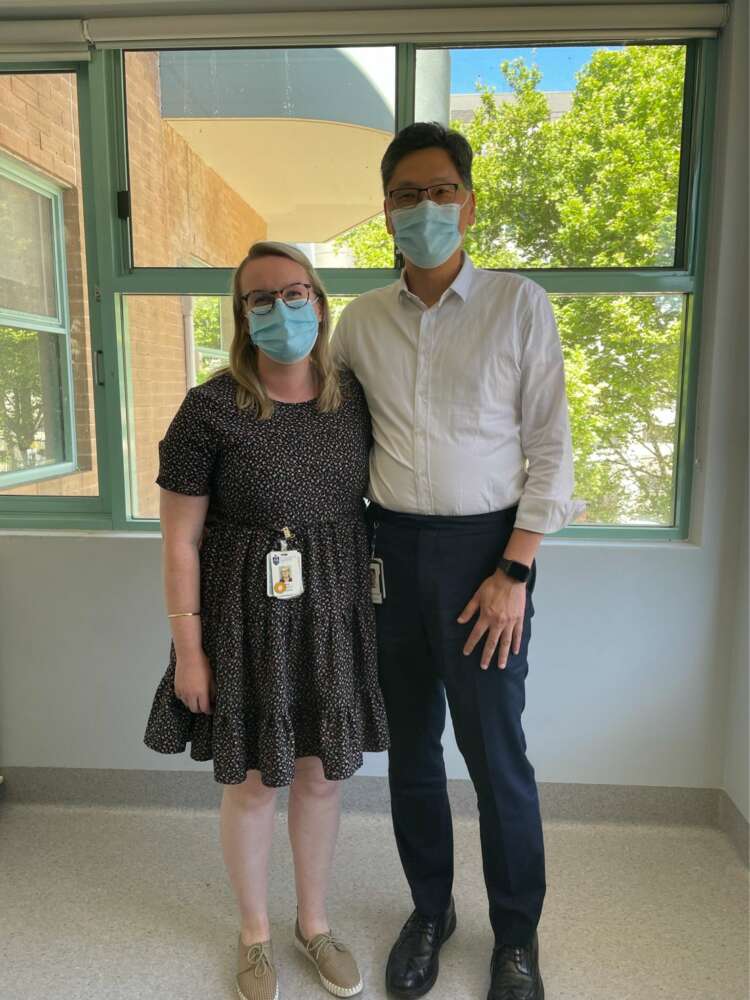
Some ideas in medical studies can look very obscure and technical to the layperson – yet in reality nothing could be further from the truth. A number will transform into very practical improvements for patients, such as those who need skilled care at the end of life. The following is a good example.“At the end of life, fluid can accumulate in the spaces around the lungs or in the abdomen,” explains nurse Nikki (Turner) Campbell.
Until recently, Nikki was a clinical nurse consultant (CNC) with the community palliative care team at Sacred Heart, Sydney. She has since moved to Melbourne, and is now a CNC with the Julia Argyrou Endometriosis Centre, Epworth.
But in Nikki’s last six months at Sacred Heart, she and her colleagues were involved in a Stanford University quality improvement project looking at permanent drains compared to intermittent drains, in patients in palliative care.
At the end of life, many cancer patients can suffer from continuously building-up fluid – and quite a lot of it. It can accumulate, particularly around the lungs and abdominal area, which is extremely uncomfortable, even distressing.
Removing excess fluid provides a lot of comfort
“It can cause a big distended abdominal area, with a tight and heavy feeling. It impairs the ability to move around, makes the person feel extremely nauseated, causes shortness of breath and constipation. Sometimes the abdomen is so distended that two litres of fluid can be drained off at a time and this may need to be done up to three times a week.
“It’s a poor prognostic sign,” Nikki explains.
In palliative care, a ‘poor prognostic sign’ means the person is very close to the end of life. At this stage of a terminal illness, cure is not possible. But providing comfort is very important and this is the reason the fluid is removed.
“We place drains under the skin and into the space around the lung or the abdomen so that we can drain the fluid away.”
A barrier to this is that it’s a difficult process for the patient, to keep putting the drains in and then removing them. The Stanford project discovered that patients were having permanent drains placed too late in their illness, and weren’t receiving the maximum benefits.
As long as the risk of infection is controlled, having them in earlier and for longer, utilising the permanent drain several times could do two things – minimise the stress of continuously being reinserted but also open up the possibility of people not needing to come into hospital to have the fluid drained. They could staying at home and have the fluid drained there.
The Quality Improvement Project found a better way of working with the drains
“The person can get good relief if we drain the fluids intermittently,” explains Nikki.
So this means, even though draining intermittently, it’s best if the drains are put in place permanently, she says.
“Without the permanent drain, because of the ordeal of inserting a drain every time and then taking out again, the experience of the draining is much more turbulent. We have to wait for larger volumes to accumulate – the person might be carrying around 10L in fluid before it is worthwhile draining it.
“But with the permanent drain end of life patients can be symptom free for longer. We don’t have to wait until it is much worse before we do something about it and the intervention doesn’t need to be as big – which carries its own risks and complications.
“Looked at over the length of the person’s last stage of life, this allows a smaller swing in the levels of fluid, but most importantly, a steady state of symptom control.”
So patients are consistently more comfortable.
“Through doing the project we found that usually in palliative care, people are receiving the drains far too late, and therefore not getting the best out of the treatment.
“For example, in our study group we were able to spare at least two patients from having a drain inserted in the last week of their life. That meant they didn’t have to stay in hospital. They were at home with their families in their last days, which is really important.”
Next step – improvements for everybody
“Hopefully, this project will encourage palliative care teams to insert permanent drains earlier and patients can have optimal symptom management and reduced number of hospital admissions during their last months of life.”
The community palliative care team at Sacred Heart, Sydney, is creating a registry of patients who’ve received drains at this stage of palliative care, so that they can improve their use and optimise patient care.
For more developments in palliative care that are helping the dying every day, go to the Good Grief website.
